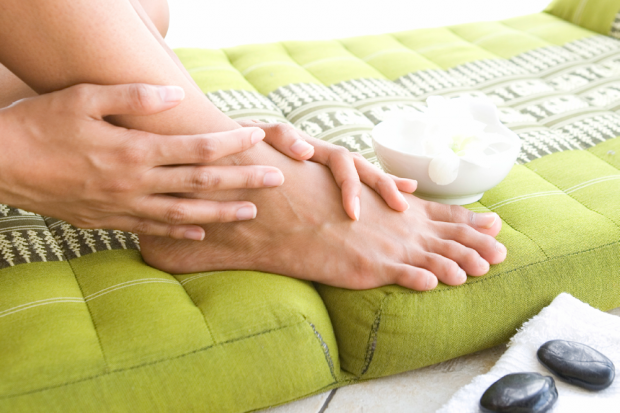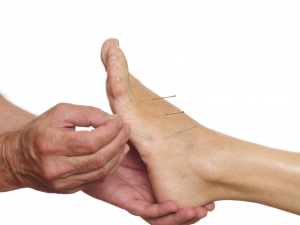Pain Relief How To Use Foot Acupressure To Heal Your Body And Relieve Pain
Using acupressure to gently stimulate certain points on your feet can reduce foot and body pain, help you lose weight, aid with digestive issues, increase circulation and so much more. Read on to find out which points you can press to achieve optimal health in your feet and beyond.
We’ve all heard that getting a massage can do wonders for your health and wellbeing, but targeting very specific points on the body with firm, massage-like pressure — called acupressure — can actually help you heal numerous ailments and significantly reduce foot and bodily pain.
The ancient form of Traditional Chinese Medicine (TCM) uses pressure applied to meridians (or acupoints) to relieve pain, treat body disorders and clear any blockages of energy so as to restore the body’s yin and yang (also known as Chi or Qi). It’s similar to acupuncture, except acupuncture uses needles instead of pressure to stimulate each meridian on the body. It is also similar to reflexology and modernreflexology, except those two methods focus on different pressure points during treatment.
Though there are many acupressure points on the body, the feet in particular possess quite a few that can help with a number of ailments, including digestive problems, stress, insomnia, headaches, problems in the intestine, weight loss, foot pain and more. Below, we show you some of the most common ailments and problems that can affect the body and how stimulating different acupoints on each foot can help reduce and relieve the pain and other symptoms associated with them.
The Benefits Of Acupressure
*Editor’s Note: Pregnant women should avoid stimulating most acupressure points and therefore should refrain from foot acupressure and other types of acupressure.
Ailments
Insomnia, hot flashes, night sweats, fever, anxiety, palpitations, poor memory, sterility, plantar fasciitis, muscular dystrophy, headache, nausea, dizziness, blurred vision, sore throat, epilepsy, intense rage
Corresponding Foot Acupressure Point:
Gushing Spring (KD 1, K1), located in the depression on the sole of your foot when it’s in plantar flexion, at the junction of the second and third toes from the heel base
Gushing Spring is located along the kidney meridian. It is the only acupoint found on the sole of the foot and can be found by sliding your fingers down your foot between the big toe and the second toe until you find a slight depression where the bones of your second and third toes meet the heel bone. Firmly press this point in the spot that is most sore for one to two minutes to help relieve pain and symptoms associated with the above ailments.
Ailments
Depression, lethargy, strong emotions, swollen genitals, PMS, cramps, breast tenderness, dysmenorrhea, amenorrhea, impotence, hernia, constipation, canker sores
Corresponding Foot Acupressure Point:
Great Surge (LV 3), located in the junction between the first and second toes
Great Surge is located along the liver meridian and can be found by sliding your finger between the big toe and the second toe until you find where the tendons meet. Firmly press this point of the foot in the spot that is most sore for one to two minutes to help relieve pain and symptoms associated with the above ailments.
Ailments
Swelling and/or pain in the feet, thirst, dry mouth, irregular menstruation, genital itching and/or pain, difficulty urinating, intense fright, chronic sore throats
Corresponding Foot Acupressure Point:
Blazing Valley (KD 2), located in a depression near the navicular bone
Blazing Valley is located along the kidney meridian and can generally be found by sliding your finger or thumb halfway up along the inside edge of your foot until you feel a notch (halfway between you heel and your big toe). Firmly press the most sensitive point in this area for one to two minutes to help relieve pain and symptoms associated with the above ailments.
Ailments
Digestive issues, weight loss issues, abdominal pain, heart pain, bunions, muscle weakness
Corresponding Foot Acupressure Point:
Supreme White (SP 3), located near the head of the joint of the big toe on each foot
Supreme White is located along the spleen meridian and can be located by sliding your finger along the edge of the inside of your foot, just past the joint of the big toe in the direction of the heel. Firmly press the most sensitive point in this area for one to two minutes to help relieve pain and symptoms associated with the above ailments.
Ailments
Abdominal pain, bloating, constipation, ankle issues including sprains and Achilles tendonitis
Corresponding Foot Acupressure Point:
Ravine Divide (ST 41), located at the midpoint of the front of your ankle in a depression between the tendons of the flexor hallucis muscle and the extensor digitorum longus muscle that is attached to the tibia bone (shin).
Ravine Divide is located along the stomach meridian and can be located by sliding your finger along the middle of the top of your foot and ankle until you find a crease where several tendons meet (at the end of your shin bone). Firmly press the most sensitive point in this area for one to two minutes to help relieve pain and symptoms associated with the above ailments.
While stimulating foot acupressure points on your own is possible, it is best to visit an acupressure expert to get the most out of the treatment therapy. Experienced acupressurists can help you fully explore the best ways to find relief for your problems and pain. Additionally, if you are experiencing foot pain, you may also want to try acupuncture, as it’s a method that can also get your body, mind and soles in a happy and healthy condition.
Notice concerning medical entries:
Articles having medical content shall serve exclusively for the purpose of general information. Such articles are not suitable for any (self-) diagnosis and treatment of individual illnesses and medical indications. In particular, they cannot substitute for the examination, advice, or treatment by a licensed physician or pharmacist. No replies to any individual questions shall be effected through the articles.







